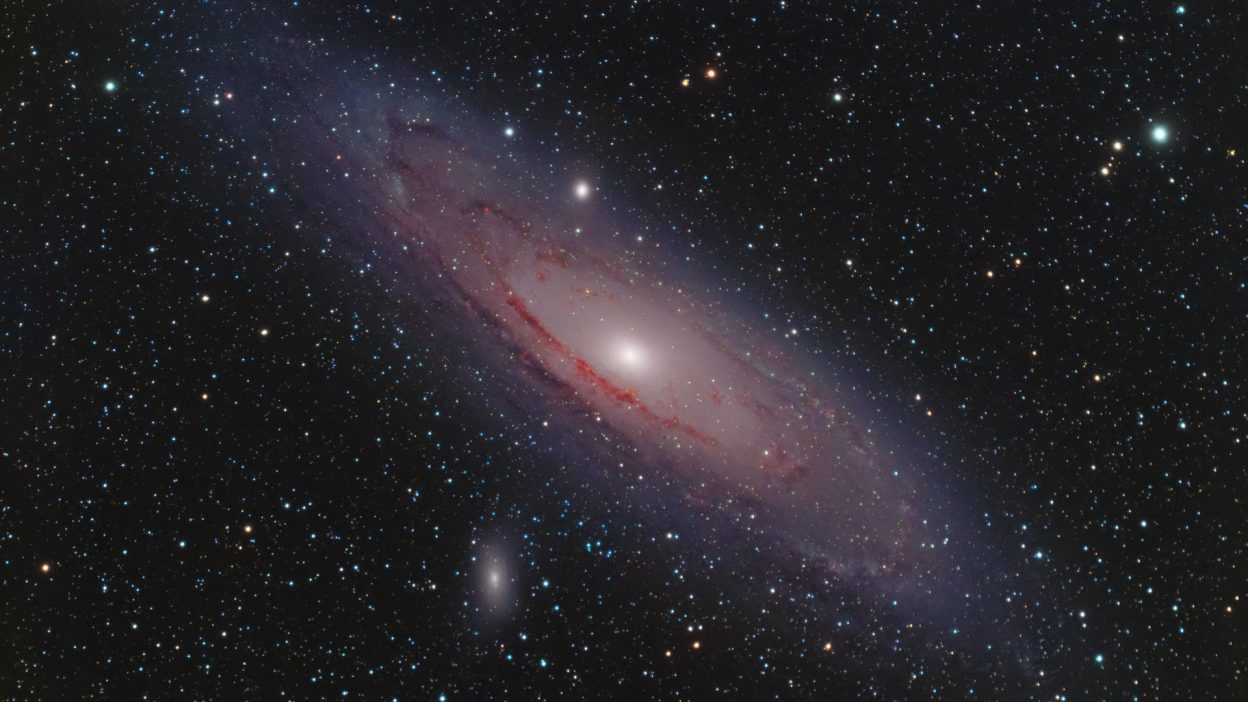There are countless amazing things that happen in the universe
Many of which take place over unfathomably long periods of time. The nearing collision between the Andromeda Galaxy and the Milky Way is one of the slowest and most fascinating events. The cosmic dance between the two galaxies has already started, even though they have been headed for collision for billions of years. Even while the complete merger won’t happen for billions of years, there is already evidence of their interaction. The first indications of this enormous cosmic event are already appearing in front of our sight, such as the movement of hypervelocity stars and the overlapping halos of these two galaxies. What does this signify for us, though? And when the Andromeda and Milky Way galaxies eventually combine to become one, what can we anticipating seeing? This blog explores this collision in depth, breaking down the science, timeline, and consequences of this extraordinary event.
Introduction:
Our home galaxy, the Milky Way, is a massive and awe-inspiring barred spiral galaxy that spans 100,000 light years in diameter. It is home to an estimated 100 to 400 billion stars, including our own Sun, as well as many other celestial objects including planets, nebulae, and star clusters. At its core is a supermassive black hole known as Sagittarius A*, which has a mass approximately 4 million times that of our Sun. This intricate structure, made up of spiral arms that wrap around the galaxy’s core, serves as the backdrop to our existence, and we are only a little part of its vast, majestic nature.
Andromeda M31, the biggest galaxy in the Local Group, is located approximately 2.537 million light-years outside our cosmic neighborhood. Andromeda, a grand spiral galaxy like the Milky Way, is significantly larger, with approximately one trillion stars. It is impressively large and has a more solid structure than our galaxy. M31 (also known as Andromeda’s central black hole) is a supermassive black hole that is 140 million times the mass of our Sun. Andromeda, with its own set of spiral arms and star clusters, is not only our nearest galactic neighbor, but also a prospective partner in a big cosmic collision that will transform both galaxies’ fates.
After years of precise observation, researchers concluded their conclusions by tracking Andromeda’s journey across the sky with the Hubble Space Telescope from 2002 to 2010. Andromeda is the closest big spiral galaxy to our own Milky Way, at around 770,000 parsecs (2.5 million light-years). Astronomers Roeland van der Marel and Sangmo Tony Sohn of the Space Telescope Science Institute in Baltimore, Maryland, presented these findings during a NASA press event in Washington, D.C.
The results will be reported in an upcoming issue of Astrophysical Journal, Sohn, S. T., Anderson, J. & van der Marel, R. P. Astrophys. J.
van der Marel, R. P. et al. Astrophys. J.
van der Marel, R. P., Besla, G., Cox, T. J., Sohn, S. T. & Anderson, J. Astrophys. J.
Key Differences Between the Two Galaxies
Both galaxies are similar in structure but differ in size and mass. Andromeda is about 2.5 times larger in diameter than the Milky Way, but our galaxy contains more gas, leading to a potentially more vibrant star formation process (NASA).
When Will the Collision Begin?
The collision of the Milky Way with Andromeda is unlikely to occur overnight or in the foreseeable future. According to current predictions, this cosmic event will commence in around 4.5 billion years. At this point, the two galaxies will begin to sense gravitational pull, which will eventually draw them together.
Though that may seem far-fetched, it is important to understand that these galactic events occur on a time scale that is significantly greater than human lifespans. The real process of merging will take billions of years and involve numerous stages and complications.
The Phases of the Collision
- Phase 1: Initial Approach (4.5 Billion Years from Now)
As the Milky Way and Andromeda approach one other, gravitational interactions will occur. These interactions will begin to twist galaxies, causing the earliest signs of a galactic collision. Stars inside each galaxy will begin to shift away from their original orbits as a result of the gravitational forces operating.
Despite the fact that galaxies contain billions of stars, the immense distances between individual stars ensure that stellar collisions are extremely rare. However, the gas and dust clouds of the galaxies will collide, resulting in intense star formation as the gas clouds compress and give birth to new stars.
- Phase 2: First Pass (Approximately 4 Billion Years from Now)
As the two galaxies approach, they will make a “first pass,” flying through each other but not merging completely. During this phase, the interaction of the two galaxies’ gravitational fields generates massive tidal forces, distorting their morphologies. The galaxies are likely to be stretched into elongated shapes, with their outer arms dragged away or twisted.
While the Milky Way and Andromeda will remain apart at this point, gravitational tug-of-war will gradually draw them closer together, laying the groundwork for the following phase.
- Merging Black Holes
The supermassive black holes in the heart of both galaxies will merge, as will the cores of the two galaxies, resulting in a new, single galactic core. The galaxies will continue to pass through each other, gradually losing energy and eventually combining into a single, merged galaxy.
- Phase 3: Full Collision (Approximately 2 Billion Years from Now)
Around 2 billion years after their first meeting, the two galaxies will begin to collide more fully. Their cores will migrate closer together, resulting in huge waves of star formation. During this phase, enormous clouds of gas and dust compress, resulting in the formation of several new stars. Some stars may be thrown into intergalactic space, while others may be drawn into the cores of merging galaxies.
Despite the enormous changes in the structure of both galaxies, individual stars are unlikely to collide due to their immense distances. However, the galactic cores will eventually interact, resulting in a phenomenon known as “galactic cannibalism,” in which one galaxy’s supermassive black hole swallows another’s.
The Final Stage: The Formation of a New Galaxy
After the Milky Way and Andromeda galaxies collide and make multiple near encounters over the following 1 to 2 billion years, they will finally combine to form a new, much larger elliptical galaxy known as “Milkomeda.” This merger will result in a galactic structure that is significantly larger and more massive than either of the original galaxies, shifting from the spiral patterns of the Milky Way and Andromeda to an elliptical form. As the two galaxies meet, fresh star formation is projected to occur, powered by the interaction of gas and dust clouds. Furthermore, the merger of their supermassive black holes will produce large amounts of gravitational waves, a phenomena already observed in other parts of the cosmos. Finally, this cosmic catastrophe will change the Local Group, resulting in the formation of a new, dynamic galactic entity.
The Fate of the Solar System
It’s unclear how our solar system will be affected. While the stars are unlikely to collide directly, the gravitational interactions that occur during the merger will affect the solar system’s orbit inside the Milky Way. This could cause changes in the Sun’s position within the new galaxy, as well as displacement to the merging galaxy’s outer regions.
However, before the actual merging occurs, the Sun will have completed its life cycle. In around 5 billion years, it will become a red giant, followed by a white dwarf, implying that the fate of Earth and our solar system will most likely be sealed well before the galaxies fully combine.
How Will the Collision End
The collision of the Milky Way with Andromeda will eventually result in a bigger elliptical galaxy, with most stars surviving the mayhem. As their supermassive black holes collide, a huge black hole will form, emitting gravitational waves. While such galactic collisions are common during the universe’s development, this one heralds the end of both galaxies in their current forms. Although humans will not see this shift, researching cosmic events helps us understand the massive forces that shape our world, reminding us of its vastness and continual change.
The Conclusion of the Collision
The collision of the Milky Way with Andromeda, though billions of years away, is a critical event in the universe’s ongoing history. Galactic mergers like this one are widespread in cosmic history, altering the structure of galaxies over long time periods. While the merger will affect both galaxies, it is only one step of the universe’s ongoing cycle of change, which will eventually result in the formation of a new, larger elliptical galaxy.
Although humans will not be able to witness this event, researching it helps us better comprehend the processes that shape galaxies and the cosmos as a whole. This collision reminds us of the expanse of space and time, demonstrating that the universe is always developing. In the broader scheme of things, the merger of the Milky Way and Andromeda is simply another chapter in the saga of cosmic evolution.
The merging galaxies emphasize that galaxies, like everything else in the universe, are always changing and serve as a metaphor for the transience of cosmic phenomena. Although we won’t be directly impacted, this event provides a window into the universe’s future by emphasizing how space, time, and the forces that govern it are always changing.




